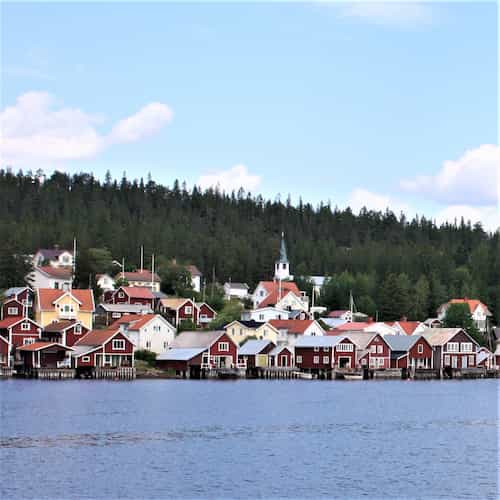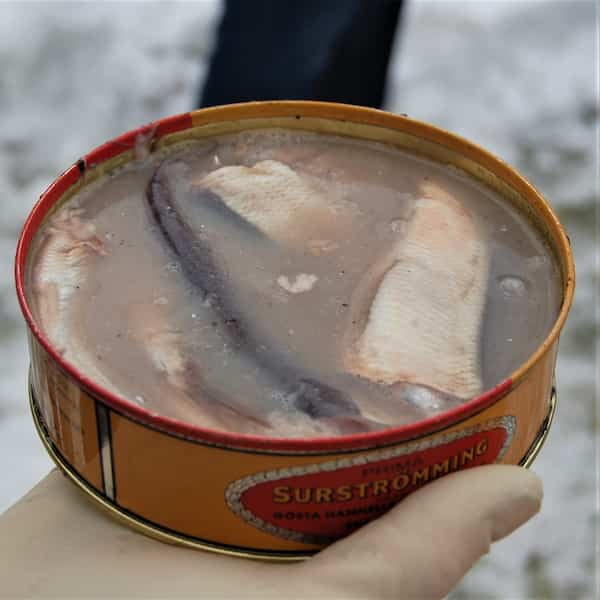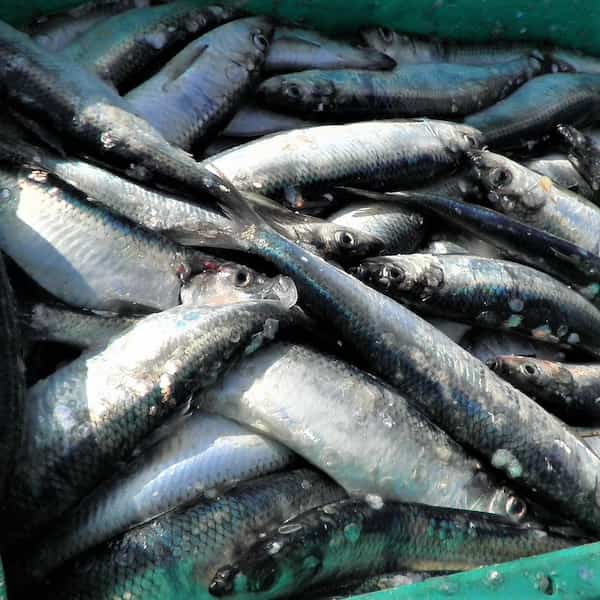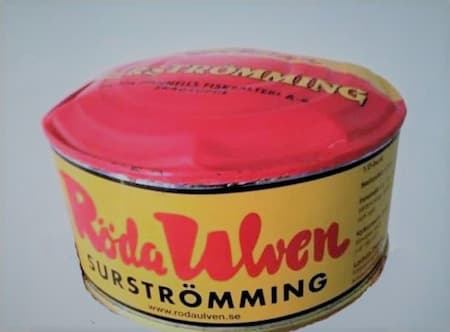What is Surströmming?
Surströmming, salted fermented Baltic herring… Is it the stinkiest food in the world?

What is surströmming?
Surströmming is a traditional dish, regarded as one of the smelliest and most disgusting foods in the world. You buy them in tin cans, and eat them cold.
Surströmming is made from small herrings from the Baltic sea, fished in May or June. After 48 hours in a high-salinity brine, they are cleaned and put in barrels in a lower salinity brine. At a temperature of about 15°C (60°F), they ferment in the barrels for 5-8 weeks. It is this process that gives it the characteristic smell. In late July or early August, they are canned and distribution starts on the third Thursday in August.

But why on earth would someone spoil food on purpose?
It is not as strange as it may seem. If you think about it… Functional refrigerators have been around for no more than a hundred years. Before that people had to use other methods to conserve food. And one very popular method was fermentation.
Fermentation doesn’t require any particular equipment or additives. It’s cheap and practical. Some of our most popular modern products originate from using fermentation as a method of conservation… Fermented milk such as Yogurt, Kefir, Ayran, etc, Pickles, all other kinds of fermented vegetables, Sauerkraut, etc, Indonesian Bagoong, Italian Bottarga, Egyptian Fesikh, and the dreaded Icelandic Hákarl, which isn’t a vegetable but a shark.
And, of course, beverages such as wine and beer…
People actually eat it, and they even enjoy it.
The surströmming is smelly, you can’t argue that. The fermentation process is completely natural. Enzymes already present in the spine of the fish (a process called autolysis) start the fermenting process. These enzymes together with bacteria produce among others, propionic acid, butyric acid, acetic acid, and hydrogen sulfide.
All these substances are each very smelly on their own, but put together they create a pungent odor, so penetrating and foul that it is impossible to even open a can in the vicinity of other people, who do not participate in the consumption. It smells like rotten eggs, or simply… Shit.
Fortunately, the actual taste of the fish is not anywhere near the putrefied odor. Once you have gotten rid of the can and rinsed the fish in freshwater, much of the smell disappears… Not all, but the whole thing becomes much more manageable. And the taste of the fish meat is very different from the first impression when you opened the lid. It is an interesting dish, particular, exotic, and in the right environment, enjoyable.
Surströmming is a very old Swedish traditional dish.
Yes, it’s a very old Swedish dish. Archaeological findings from 7000 BC in southern Sweden, suggest that fermentation already was a well-established method for food conservation. And the technique was known all over the world. The ancient Romans as well as the Greeks used fermentation to preserve food.

In Sweden, the commonly used method to preserve their basic food, the herring, was salting. But salting requires salt, and when Gustav Vasa, the first King of modern Sweden, started a decades-long campaign of warfare against practically all of Sweden’s neighbors at the beginning of 1500, the salt import came to a halt. Sweden had no domestic production of salt and that meant higher prices and less supply.
We don’t know if the farmers knew exactly what they were doing or not, but when they suddenly put much less salt on the herrings, the fermentation process began. And the surströmming was invented.
Surströmming today
The production is concentrated in the north of Sweden. And so is the eating of the smelly fish. It’s much more common in the northern parts of the country, where the big forests are with bears, wolves, and moose. The production was once concentrated in the area of Höga Kusten (The high coast… From the characteristic rocky coastline.), between Härnösand and Örnsköldsvik.
Here there used to be a lot of small, often family-owned companies, that produced the famous round tin cans. Especially on the island Ulvön, where every corner of the road used to have its own surströmming factory. The classical round tin can became the classic package around 1890.

Another reason why this part of Sweden became the center for surströmming production is the quality of the herring. The last part of the name -strömming indicates a smaller type of herring found in the Baltic sea. It is not only smaller than the Atlantic variant but less fat and, honestly, quite different in taste. The fat content is crucial when fermenting. And in the southern Baltic sea, the herring is too fat, while in the north it’s too lean. The perfect herring for fermentation is found right there, between Härnösand and Örnsköldsvik.
Eating surströmming the correct way.
Well, the natives eat it just like any other fish, without any distinct recipes or special tricks… But if you would want to try it, and succeed, you would need a little guidance. Here is the best advice from the experts:
- Open the can far away from the table. Be prepared… The smell is overwhelming. You can even open the can inside a bucket of water, and flush the fish right there.
- Rinse the fish filets in sparkling water. Store the empty cans safely in a closed space.
- The accessories can vary quite a lot. There are some basic items that definitely should be served. Those are boiled potatoes (mandelpotatis, almond-shaped, small potatoes boiled unpeeled, if you have access to it.), onion (white or red is preferable), sour cream (gräddfil)(…or any other sour dairy product), and tunnbröd (flatbread).
- The best way to enjoy the surströmming is to make a roll (klämma). Fill a flatbread with potatoes, onion, and sour cream. Add small pieces of surströmming, as a condiment rather than the main ingredient. Roll it up and eat it with your hands.
- … And it should be accompanied by local beer, and snaps (vodka)
There are loads of videos out there showing people doing the surströmming challenge. They sit indoors with a can, but without anything else. Then they open it and eat the herrings right out of the package dripping with the oozing marinade. The most enthusiastic surströmming-expert would never, ever come near a situation like that. It’s completely and utterly foolish.
Is it healthy to eat?
Fermented food in general has many beneficial properties and a few harmful effects. The good thing about it is mostly connected to probiotics — live microorganisms. Those are extremely important for digestion. And the bad is much the same… Some of the microorganisms could turn out harmful.
An additional hazard comes from the health of the seawater. High levels of PCB and dioxins have been found in fatty fish like salmon and herring from the Baltic sea. Although the levels are decreasing, it’s a very slow process. The European Union has issued a permanent exception for consuming herring and salmon from the Baltics, as the levels of PCB and dioxin currently are over the safe limit.
Eating it once or twice a year doesn’t have any implications, but if you open a can two or three times a week, it could be harmful, especially if you’re are pregnant, plan to have children, or simply very young.
Is surströmming rotten?

No, surströmming is not rotten. Rotting is an uncontrolled, natural process. Many different bacterias cause the decomposition of organic material. Putrescine, cadaverine, indole, and skatole are among those most frequently produced. These are not present in surströmming.
Fermentation, on the other hand, is accomplished under controlled circumstances. The precise salt level limits the process and allows only certain enzymes and bacteria to work. I.e. those that enhance the development of the aroma and the flavor, such as hydrogen sulfide.
So which is the stinkiest food in the world?
It is difficult to say. Salinity and spiciness can be measured in the laboratory, although not 100% objectively. The Smell is more difficult. The substances that stimulate our nose are many, not only one. And we are differently sensitive to all of them. The Guinness Book of records doesn’t have a record for smelliness, and there’s probably a reason for that.
Still, when I search for the most stinking and putrid foods in the world, surströmming always comes up, and more often than not in one of the top positions.
Other stinky foods include stinky tofu, fruits like Locust and Durian, and the Japanese Nattō. But there are many more. Many of these are restricted, you can’t take them on flights, they don’t serve them in restaurants, etc. I’ve eaten some of these myself, and some of them are frankly quite disgusting.
But comparing this to surströmming seems ridiculous. If you would ever open a can of fermented Baltic herring on an airplane, they would have to refurbish it completely. The stench would penetrate everything that isn’t steel or smooth plastic… And the smell of surströmming isn’t just strong… It smells rotten. So I would say the type of smell is more disturbing than many others.
 The final verdict
The final verdict
- Surströmming isn’t all that bad to eat. It’s the smell that hurts.
- The smell is of a kind that is very disturbing to us humans, feces, rotten eggs, death, and decay.
- Surströmming is exclusively served outside, and very far away from everybody else. It could never be served in a restaurant, not even outside.
- The can is hermetically closed. Compared to more traditional packings like fruit, eggs in clay, or even plastic or paper boxes, the sealed can is odor-free. If it wasn’t, it could never be distributed.
Considering all this, I would consider it the winner. Surströmming is the stinkiest dish in the world. Obviously not counting things that are smellier but not digestible… Like food gone bad, or edibles not normally sold, distributed, and anyway reasonably healthy.
Yes, it is. Surströmming is the smelliest dish in the world.

If you don’t agree, just open a can from last year… A can that was ready in August but was left for another entire year to amplify the fermentation and decay of the herring muscle tissues. A can containing something so putrefied that it’s become spherical, like a ball…
sources